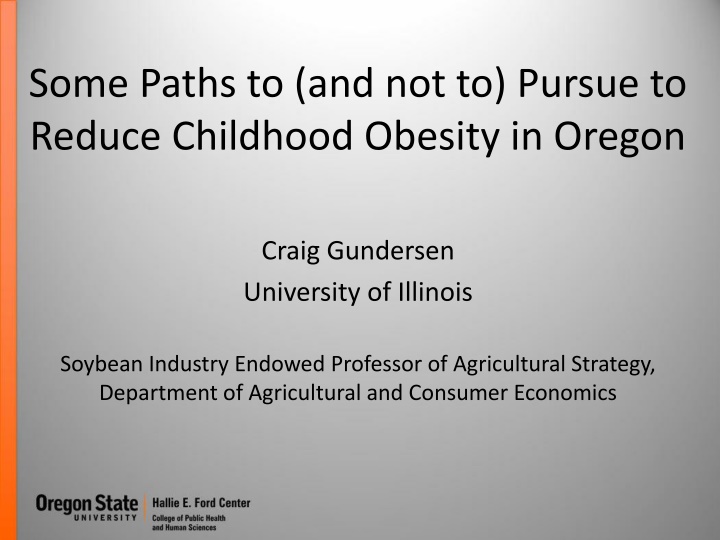Strategies to Address Childhood Obesity and Food Insecurity in Oregon
Various paths to reduce childhood obesity and food insecurity in Oregon are discussed, including the impact of SNAP, soda taxes, and key objectives to focus on. The importance of ensuring interventions do not cause harm over other dimensions is highlighted. The evidence on soda taxes, SNAP program, and their effects on obesity, food insecurity, and health outcomes are analyzed in depth.
Download Presentation

Please find below an Image/Link to download the presentation.
The content on the website is provided AS IS for your information and personal use only. It may not be sold, licensed, or shared on other websites without obtaining consent from the author.If you encounter any issues during the download, it is possible that the publisher has removed the file from their server.
You are allowed to download the files provided on this website for personal or commercial use, subject to the condition that they are used lawfully. All files are the property of their respective owners.
The content on the website is provided AS IS for your information and personal use only. It may not be sold, licensed, or shared on other websites without obtaining consent from the author.
E N D
Presentation Transcript
Some Paths to (and not to) Pursue to Reduce Childhood Obesity in Oregon Craig Gundersen University of Illinois Soybean Industry Endowed Professor of Agricultural Strategy, Department of Agricultural and Consumer Economics
Child Obesity Rates by Income to Poverty Line Ratio 2001-2010 >95th %tile >99th %tile 20 15 Percent 10 5 0 <1 1-2 2-3 3-4 >4
Child Food Insecurity Rates by Income to Poverty Line Ratio 2015 Food Insecure-Household Food Insecure-Children 40 30 Percent 20 10 0 <1 1-1.3 1.3-1.85 >1.85
Key Objectives Reduce childhood obesity Ensure that interventions do not cause harm over other dimensions
Soda Taxes Do they lead to reductions in soda consumption? Yes standard economic theory Will they generate increased revenues for Oregon? Yes standard economic theory Do they lead to improvements in health? No evidence in support of this Do they lead to reductions in obesity No e.g., Fletcher et al., 2010; Fletcher et al., 2014 Will they lead to increases in food insecurity? Yes e.g., Gregory et al., 2013; Courtemanche et al., 2015
Supplemental Nutrition Assistance Program (SNAP) Primary goal is to alleviate hunger Benefit levels function of income and family size maximum benefit level is $649 for a family of four average benefit level is about $300 for a family of four Size of program serves almost 45 million persons total cost is about $80 billion per year Eligibility criteria gross income test income less than 185% of the poverty line in Oregon $3,738 for a family of four net income test income less than the poverty line (after deductions) - $2,021 for a family of four asset test not binding in Oregon
SNAP and Obesity Majority of evidence is that, in comparison to SNAP eligible children, SNAP recipients are either no more likely to be obese less likely to be obese for review, see Gundersen, 2015 Recent evidence shows that higher SNAP benefits are associated with lower probabilities of obesity Almada and Tchernis, 2015
Restrictions on SNAP Purchases Will this lead to increases in obesity among children? Maybe Will this lead to increases in food insecurity? Yes Declines in SNAP participation Stigma Transactions costs for review, see Gundersen, 2015 Increases in food prices
Better Approaches to SNAP and Obesity Resist block granting Would sharply restrict SNAP s ability to work as a safety net Encourage increased participation rates Albeit, already high in Oregon Recognize benefits over multiple dimensions Support even higher benefit levels Recognize benefits over multiple dimensions























